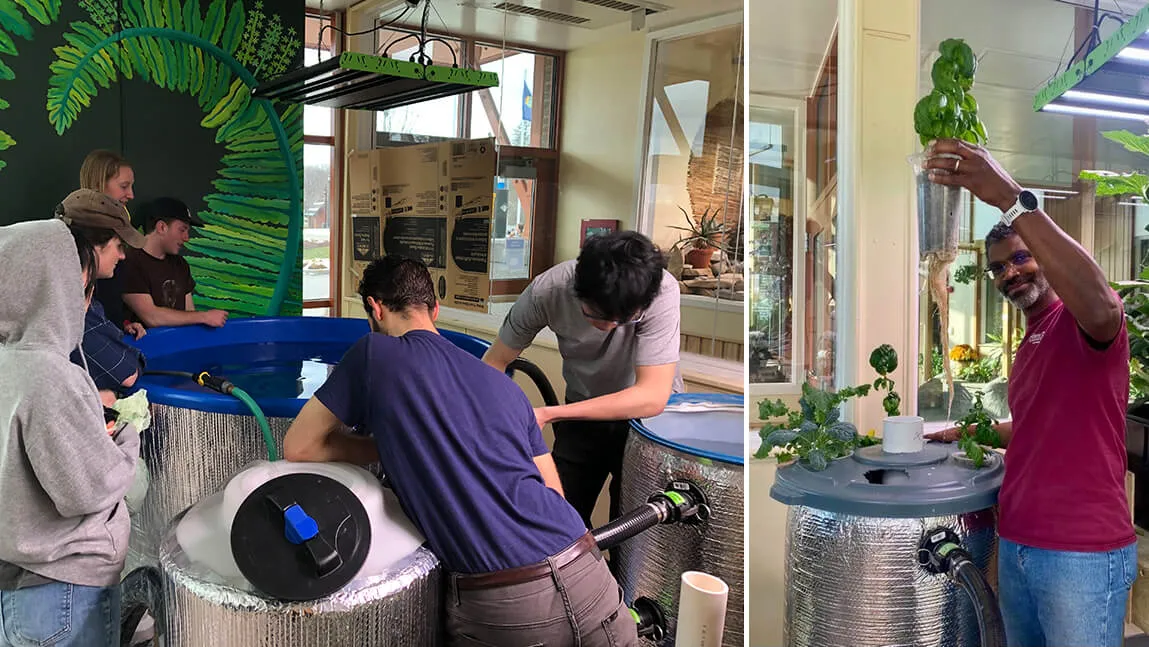While aquaculture, the growing of food—from fish to plants to algae—in water, has been a focus of research and workforce development in coastal states for decades, the field is just beginning to gain traction in the Lake Champlain basin.
In the wake of COVID-19, Lake Champlain Sea Grant hired an aquaculture specialist, Theo Willis, to introduce land-based aquaculture to the watershed to increase local food security and develop an aquaculture education program. Willis soon fostered multiple partnerships in the region, including with the University of Vermont (UVM) Rubenstein School of Environment and Natural Resources, to educate and engage students.
In the spring of 2022, Willis and Eric Roy, an associate professor in the Rubenstein School and in the College of Engineering and Mathematical Sciences, collaborated to build an aquaponics system in the Eco-Design Makerspace, located in the Aiken Center at UVM. Aquaponics is a food production system that couples aquaculture with hydroponics and uses nutrient rich fish waste to feed and grow plants. The Eco-Design Makerspace formerly housed the Eco-Machine, a living laboratory that successfully treated 760,000 gallons of the building's wastewater over five years. The Makerspace is highlighted in campus tours and receives many visitors from students, prospective students, and community members.
Roy and his Ecological Design students transformed the space into a display of student projects that model elements of a circular economy and nutrient recovery, which both emphasize using conventional waste products in a new way. The Makerspace showcases student-designed microcosms, hydroponic growing systems, fungi cultivation and experimentation, and nature-based art. Adding aquaponics to the display was always an exciting prospect for Roy.
With Willis’ guidance, about ten students in Roy’s Advanced Ecological Design course helped to build the aquaponics system. The class was a mix of environmental sciences students and engineering students, each bringing their own expertise. Students from the class continue to be the main stewards of the system, as they collect data about nutrient levels, temperature, pH, and chlorine to ensure the system maintains balance and efficient production of both fish and plants.
“We hope this system acts as an example to teach passers-by what aquaponics systems are,” shares Rubenstein School student Hailey Sanphy, a senior in Environmental Sciences, who is monitoring the system. “We want to show that aquaponics systems are scientific, but they’re also accessible, efficient food sources!”
Aquaponics System Details
The aquaponics system at the Aiken Center consists of a series of tanks, each with a different purpose. The first tank is the biggest; this is where the nearly 150 tilapia fish live and feed. The water is then sent into a smaller tank called the clarifier, where the largest particles of fish waste are strained out and removed. Here, plants like basil and kale can thrive above the filter media and grow deep roots.
The next—and maybe most important—tank is the biofilter. The same size as the clarifier, this tank is set up with small clay pebbles covered with beneficial bacteria that convert ammonia from fish waste into nitrite and then nitrate, a usable nutrient for plants that, unlike ammonia and nitrite, is not toxic to fish. The newly nitrified water is then pumped into the main plant bed. The bed takes about 20 minutes to fill up with water which allows the roots of the plants and the bacteria to soak in the nutrients before draining to bring oxygen back into the system.
Finally, the water is pumped through a traditional hydroponics system that uses a nutrient film technique to feed the plants. The water eventually circulates back to the fish tank.
“The whole system is a tricky balance; everything has to be just right for the fish, bacteria, and plants to be happy,” explains Willis. “That’s why we have constant monitoring of variables. The students coded and assembled a monitoring system that sends updates right to their email. If something isn’t looking right, we can catch little problems early before they become big issues.”
In these aquaponics systems, Willis, Roy, and the students grow kale, greens, okra, and numerous herbs, and they hope to add other vegetables to the mix soon. They have a growing partnership with the UVM Rally Cat’s Cupboard to donate the harvests. Rally Cat’s Cupboard is an on-campus food pantry focused on increasing food security at the university.
